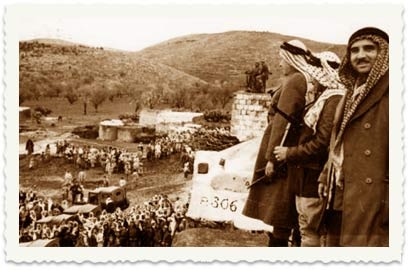Info
District: Haifa
Population 1948: 1390
Occupation date: 13/04/1948
Jewish settlements on village/town land before 1948: None
Jewish settlements on village/town land after 1948: Midrakh Oz
Background:
Al-Mansi Before 1948
At a distance of 30 km from Haifa, the village was located on the western edge of the plain Marj ibn 'Amir, south of the Haifa-Jinin highway. Out of the 1,200 inhabitants, 20 of Christian and the rest Muslim. Their houses were built of stone with mortar, made of cement or mud, and some had roofs made of wood, straw and mud. They were either spaced apart from each other, or clustered together. Al-Mansi had a boys' elementary school, a mosque, and a mill, and at least six springs. Its economy depended on agriculture - especially grain, olive, and vegetable cultivation - and animal husbandry.
Occupation, Depopulation, and Israeli Settlements
During the night of 12-13 April 1948, Palmach units moved on al-Mansi, occupying it along with the village of al-Naghnaghiyya. Zionist forces had been locked in battle with the Arab Liberation Army (ALA) over the nearby settlement of Mishmar ha-'Emeq since 4 April. The Palestinian newspaper Filastin reported that Zionist forces had infiltrated al-Mansi a few days before, on 9 April, and had exchanged fire with its defenders. ALA commander Fawzi al-Qawuqji reported that his forces withdrew to the village on the afternoon of 11 April after a 'violent' Jewish counterattack. When the ALA had proposed a ceasefire in the battle, the Haganah commanders rejected the offer and decided to counterattack extensively, occupying and destroying the surrounding villages.
All the houses of al-Mansi were blown up over the following days, according to Israeli historian Benny Morris, and the residents were probably displaced at the same time. However, at the end of the following month, the New York Times reported that Israeli columns cut into the Triangle area from the northwest, occupying al-Mansi and other villages. This may indicate that the Haganah did not maintain a constant presence in the village.
Midrakh 'Oz was built close to the village site in 1952, partly on village land.
The Village Today
The remains of the school and the mosque are still standing in the midst of a thick undergrowth composed of vines and thorny bushes. The exposed foundations of the village buildings, surrounded by stone rubble, can be seen throughout the site. There are many cactuses and trees. The agricultural kibbutz of Midrakh 'Oz occupies part of the adjacent land, while the rest is used for growing avocado trees and raising poultry and cattle.
------------------
Source: al-Khalidi, Walid (ed.). All that remains: the Palestinian villages occupied and depopulated by Israel in 1948. Washington DC: 1992.


